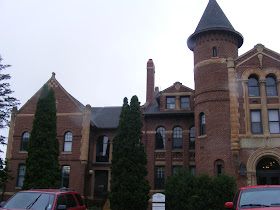This building was our next intentional destination (that is not just a place to spend the night).
I was frustrated at not being able to get the whole thing into one picture.

It was massive and this was just the administration building.

I was thinking how the turret made me think of Disneyland, but of course this isn't Disneyland, it's the
You might remember me telling you that I learned from a complete stranger that my Dad was adopted, something I never knew and I believe he didn't either. My seeking verification of this information from other family members led to an invitation to a family reunion. Bill's always ready to go to the US and I thought this was an opportunity not to be missed, so we went. My visit to the State School was on the cards from the time we booked our tickets.
"Orphan History
Unfortunately, since the birth of our nation, there have been neglected, abused, and orphaned children. In fact, many orphans were exported to the Colonies to provide inexpensive labor. [Exportation of children from Britain continued even after World War II, apparently as late as even 1970.]
During the early 1800s, the number of orphaned children multiplied as poor immigrants poured into the country, many leaving their young children behind on the streets of New York City. Almhouses (poor homes) and orphanages were opened by states and religious orders to care for the children.
Yellow fever, cholera, and typhus epidemics continued to increase the number of orphaned children.
When the Civil War ended in 1865, the number of orphans in almhouses increased by 300 percent. Whereas in 1825 there had been two orphan ‘asylums’ in New York State, by 1886 there were sixty, and even these were not enough to take care of the homeless children. Again the children swarmed city streets.
Charles Loring Brace, who headed the Children’s Aid Society, believed “there was no better way to cool the passions of the girls and shield the boys from a life of crime than to send them to work on farms.” [I find that an interesting turn of phrase] With a reformer’s energy, he organized “orphan trains” to transport city waifs to families out West who were willing to take them in. On arrival at their destination, the “orphan train” children were greeted by a crowd of applicants who looked them over and made their selections. From the mid-1800s to 1924 an estimated 100,000 children were sent West on “orphan trains.”
By 1885, the state ofMinnesota likewise felt the need to better care for its dependent and neglected children. Many child-welfare workers of the day agreed that removing children from almhouses and placing them in a family home in the country was best for the child. Any institution should only be a temporary home and should use a homelike setting with the youngsters housed in cottages rather than in large dormitories.
In June of 1885, the Legislature appointed a commission to adopt such a plan and look for a suitable site. Owatonna [one of nine towns to submit propositions]...offered 160 acres of land with all necessary wells for the use of the institution and all building materials delivered on the grounds free of freight charges.
In June of 1885, the Legislature appointed a commission to adopt such a plan and look for a suitable site. Owatonna [one of nine towns to submit propositions]...offered 160 acres of land with all necessary wells for the use of the institution and all building materials delivered on the grounds free of freight charges.
Headlines in the Owatonna Journal on Friday, July 8, 1885 announced that Owatonna had been chosen for the side [sic] of the new school..."


Hm, just recently in my own travels I came across a museum for the orphan trains in northern Kansas. You might be interested in that.
ReplyDeleteWow. I'd never heard of 'orphan trains' until I started reading about Owatonna. Guess they were far moe widespread than I knew. This is a part of history I've never encountered before!
ReplyDeleteBeing from MN I had never heaard of this home, interesting. I had heard of the trains that brought the children to other parts of the country. Imazing how our history has been hidden.
ReplyDeleteJoanne - I don't know if it's so much hidden as just past. The orphan train thing was more about immigration perhaps whereas following waves of children adoption were more about illegitimacy and social disapproval. By 1945 Owatonna was a home for mentally handicapped children, not orphans, so things had changed quite a bit.
ReplyDeleteIn 1995, PBS made a documentary about orphan trains. There are a number of books on the subject, even a series of children's books written by Joan Lowery Nixon called "Orphan Train Books".
ReplyDelete~skye